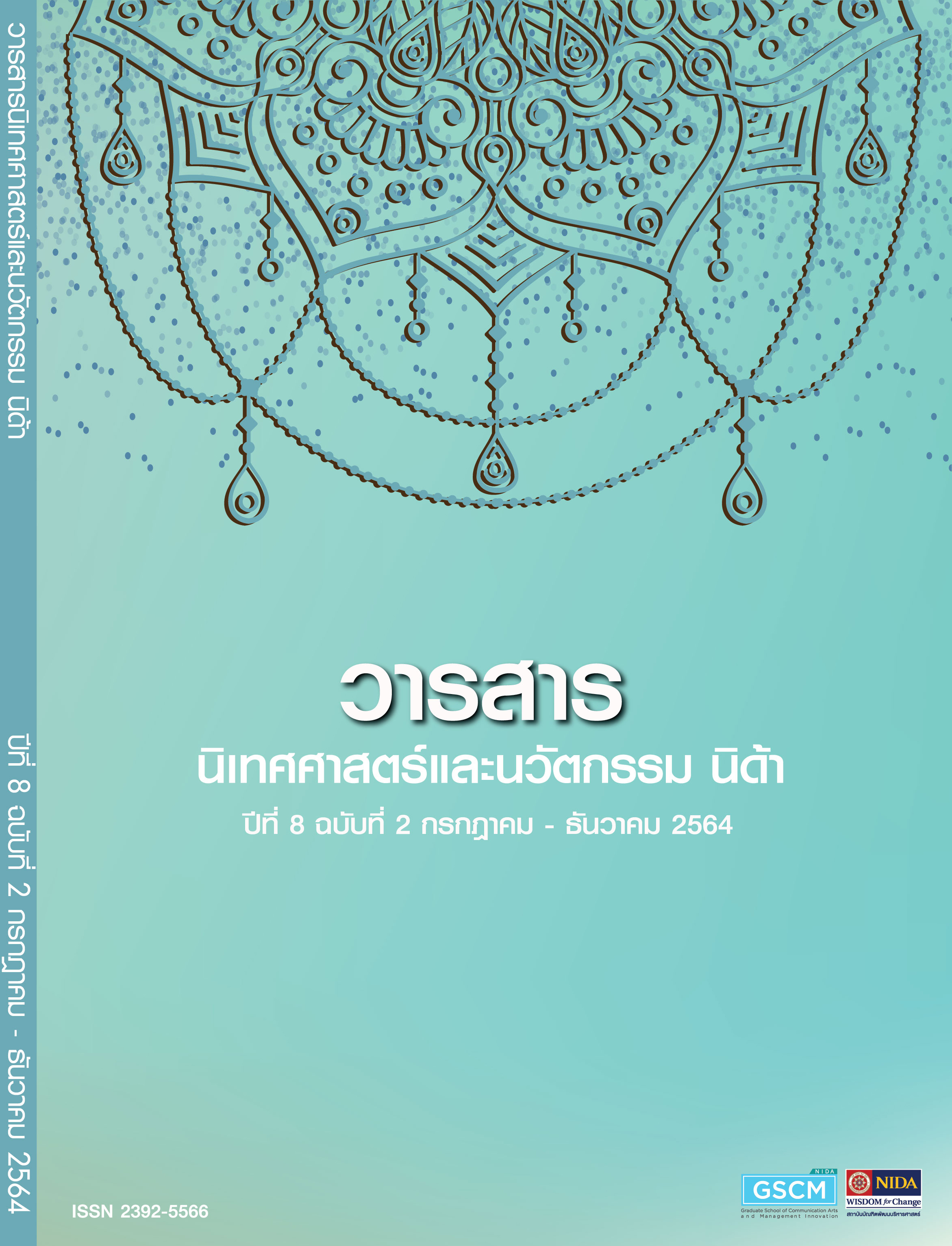The Construction of Signification Through Youtube Program, in The Sixth Sense: Khon Hen Phi
Main Article Content
Abstract
The qualitative research aimed to analyze the content, presentation, and the construction of signification through youtube program and analyze how it reveals the construction of the meaning in The Sixth Sense: Khon Hen Phi. The textual analysis was conducted with twelve episodes broadcast in 2020 - 2021. From the study, it was found that the Sixth Sense: Khon Hen Phi applied to the reality TV format of the ghost hunter investigated by the clairvoyance. Besides that, the result revealed the 5 steps of the narrative structure; (1) introduction the conflict of the human and ghost (2) the clairvoyance meets ghosts (3) the clairvoyance communicated with ghost or exorcised the ghost (4) the good ghosts were restrictive duty and the bad ghosts were eliminated from the world (5) the conclusion of the story. The research also found that the construction of signification in The Sixth Sense: Khon Hen Phi program which is divided into 5 types of the meaning; (1) the meaning of “ghost” (2) the meaning of “the clairvoyance” (3) the meaning of the “ritual” (4) the meaning of the “Sixth Sense: Khon Hen Phi” program and (5) the others meaning that appeared in the program.
Article Details

This work is licensed under a Creative Commons Attribution-NonCommercial-NoDerivatives 4.0 International License.
ข้อความและความเห็นในวารสารนิเทศศาสตร์และนวัตกรรม นิด้า เป็นของผู้เขียนแต่ละท่าน มิใช่ของคณะนิเทศศาสตร์และนวัตกรรมการจัดการ สถาบันบัณฑิตพัฒนบริหารศาสตร์
References
กาญจนา แก้วเทพ. (2544). ศาสตร์แห่งสื่อและวัฒนธรรมศึกษา. กรุงเทพฯ: จุฬาลงกรณ์มหาวิทยาลัย.
กาญจนา แก้วเทพ. (2552). สื่อสารมวลชน:ทฤษฎีและแนวทางการศึกษา. กรุงเทพฯ: ห้างหุ้นส่วนจำกัดภาพพิมพ์.
กาญจนา แก้วเทพ (2553). แนวพินิจใหม่ในสื่อสารศึกษา. กรุงเทพฯ: ห้างหุ้นส่วนจำกัดภาพพิมพ์.
กาญจนา แก้วเทพ. (2554). สื่อเก่า สื่อใหม่ ใจเชื่อมร้อย. กรุงเทพฯ: ห้างหุ้นส่วนจำกัดภาพพิมพ์.
ณัฐนนท์ ฤกษ์พึ่งดี และกฤษณ์ ทองเลิศ. (2558). การผลิตและการประกอบสร้างความกลัวในรายการคนอวดผี. การประชุมวิชาการระดับชาติ มหาวิทยาลัยรังสิต, (1637-1645).
จิธิวดี วิไลลอย. (2559). การปรับแปลงความหมายผีในละครโทรทัศน์ไทย. วารสารนิเทศศาสตร์, 34(2). 47-69.
ดิฐพงศ์ ประเสริฐไพฑูรย์ และสรรพัชญ์ เจียระนานนท์ (2562). การสื่อสารวัฒนธรรมท้องถิ่นในโลกดิจิทัล ผ่านเรื่องเล่าเกี่ยวกับวิญญาณในรายการผีออนไลน์. การประชุมวิชาการระดับชาติ มหาวิทยาลัยสุโขทัยธรรมาธิราช ครั้งที่ 9, (1-16)
นิธิ เอียวศรีวงศ์. (2562). พุทธ-พราหมณ์-ผี หรือ ผี-พราหมณ์-พุทธ (1). สืบค้นเมื่อวันที่ 5 กุมภาพันธ์ 2565. จาก https://prachatai.com/journal/2019/11/85308
นิโลบล นาคพลังกูล. (2558). ผีในลาว. วารสารภาษาและหนังสือ, 46. 34-48.
ภัสธิดา และถิ เหวียด ห่า. (2558). ชีวิตหลังความตายและเดือนแห่งวิญญาณร้ายในเวียดนาม. วารสารภาษาและหนังสือ, 46. 9-33.
ยศ สันตสมบัติ. (2556). มนุษย์กับวัฒนธรรม. พิมพ์ครั้งที่ 4. กรุงเทพฯ: สำนักพิมพ์มหาวิทยาลัยธรรมศาสตร์.
เสถียรโกเศศ. (2533). ประเพณีเกี่ยวกับชีวิต. พิมพ์ครั้งที่ 5. กรุงเทพฯ: ศยาม.
สมสุข หินวิมาน. (2558). อ่านทีวี การเมือง วัฒนธรรมในจอโทรทัศน์. กรุงเทพฯ: ภาพพิมพ์.
ศรีศักดิ์ วัลลิโภดม. (2550). เล่าขานตำนานใต้. กรุงเทพฯ: ศูนย์ศึกษาและพัฒนาสันติวิธี มหาวิทยาลัยมหิดล.
อัศวิน เนตรโพธิ์แก้ว. (2561). สื่อศาสตร์ หลักการ แนวคิด นวัตกรรม. ปทุมธานี: นาคร.
Beck, D., C.Hellmueller, L., & Aeschbacher, N. (2012) Factual Entertainment and reality TV. Communication Research Trends, 31(2). 4-27.
Fiske, J. (2011). Television Culture. London: Routledge.
Holmes, S., & Jermyn, D. (Eds.). (2004). Understanding reality television. Routledge: New York.


